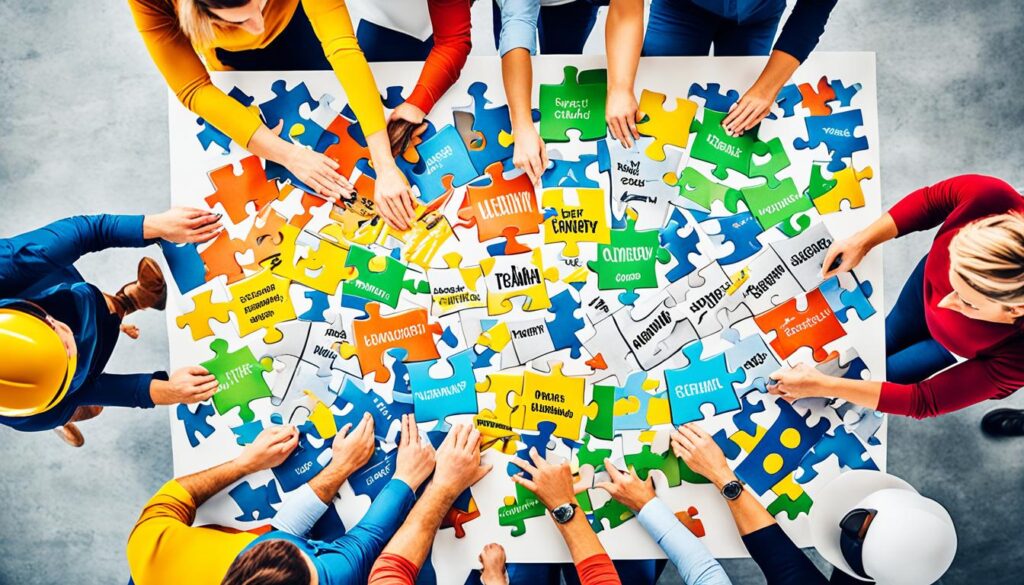Imagine a workplace where collaboration flows effortlessly, ideas spark creativity, and communication is clear and effective. In this environment, teams effortlessly build on each other’s strengths, fostering synergy that leads to exceptional performance. This is the power of optimized team dynamics in the workplace.
Meet Lisa, a project manager at a tech startup. She is known for her ability to build strong teams and enhance their performance through positive team dynamics. Lisa understands that when team members feel connected and supported, they are more likely to collaborate, communicate openly, and bring their best to the table.
One day, Lisa was assigned a challenging project that required cross-functional collaboration and innovation. She assembled her team, consisting of individuals from different departments, backgrounds, and expertise. Lisa knew that forging a cohesive and productive team was crucial to the success of the project.
She started by fostering a positive team culture, where every idea was valued, and each member felt heard and respected. Lisa encouraged open communication, creating a safe space for team members to voice their opinions and share their expertise. She promoted teamwork and collaboration, emphasizing the importance of leveraging each other’s strengths.
As the project progressed, Lisa noticed how the optimized team dynamics positively influenced the team’s performance. They were solving challenges collectively, brainstorming innovative solutions, and supporting each other’s growth. The team exceeded expectations, delivering exceptional results that impressed both clients and upper management.
Lisa’s success story highlights the significance of optimizing team dynamics in the workplace. When teams are equipped with effective communication, trust, collaboration, and a positive culture, they can achieve remarkable outcomes.
Key Takeaways:
- Optimized team dynamics enable effective teamwork and collaboration.
- Positive team dynamics lead to improved communication and innovation.
- Building a strong team culture fosters trust, respect, and synergy.
- Enhancing team performance requires open communication and collaboration.
- Optimized team dynamics contribute to a positive and productive work environment.
The Importance of Positive Team Dynamics
Positive team dynamics play a critical role in the success of teams and organizations. When teams foster a culture of collaboration, teamwork, and mutual support, they experience numerous benefits that contribute to their overall effectiveness and productivity.
One of the primary benefits of positive team dynamics is the promotion of effective teamwork and collaboration. When team members trust and respect one another, they are more likely to communicate openly, share ideas, and work together towards a common goal. This collaboration leads to innovative solutions, increased efficiency, and better decision-making processes.
In addition, positive team dynamics positively impact employee engagement. When team members feel supported and valued within their team, they are more likely to be motivated, committed, and invested in their work. This high level of engagement results in higher productivity, job satisfaction, and overall employee well-being.
Furthermore, positive team dynamics contribute to increased productivity. When team members work well together, tasks are completed more efficiently, problems are solved more effectively, and goals are achieved with greater success. The collaborative environment nurtured by positive team dynamics enables teams to leverage the diverse skills and expertise of its members, leading to improved outcomes.
Organizations that prioritize positive team dynamics also tend to experience lower levels of burnout. When teams function in a supportive and inclusive environment, the well-being of individual team members is safeguarded, resulting in reduced stress, enhanced job satisfaction, and increased overall team resilience.
In summary, positive team dynamics are vital for the success of teams and organizations. By fostering teamwork, collaboration, employee engagement, and productivity, organizations can reap the benefits of a cohesive and high-performing workforce.
Strategies for Optimizing Team Dynamics
Optimizing team dynamics requires a proactive and targeted approach from leaders. Effective leadership plays a critical role in optimizing team dynamics. Leaders should practice effective leadership by getting to know their employees, trusting them to perform well, and gaining their trust in return.
Encouraging a culture of open communication is also crucial for optimizing team dynamics. Clear and frequent communication helps build trust and empowers team members to voice their concerns and ideas.
Developing positive relationships based on trust and respect is another key aspect of optimizing team dynamics. When team members trust and respect one another, it fosters collaboration and cooperation, leading to better outcomes.
Clearly defining roles and responsibilities and ensuring transparency in communication helps eliminate conflicts and confusion. When team members have a clear understanding of their roles and responsibilities, they can work together more effectively towards shared goals.
Leading with a growth mindset, where individuals believe in the potential for growth and improvement, can also contribute to positive team dynamics. Embracing a growth mindset encourages team members to be open to learning, challenges, and feedback, leading to continuous improvement and innovation.
Facilitating collaboration and providing opportunities for increased teamwork is essential for optimizing team dynamics. Collaboration allows team members to leverage their diverse skills and perspectives, leading to better problem-solving and decision-making.
Key Strategies for Optimizing Team Dynamics:
- Practice effective leadership
- Promote open communication
- Foster trust and respect
- Define clear roles and responsibilities
- Embrace a growth mindset
- Facilitate collaboration
By implementing these strategies, leaders can optimize team dynamics and create a positive and productive work environment that drives success.
Example Table: Team Dynamics Optimization Checklist
| Strategy | Description |
|---|---|
| Effective Leadership | Develop strong leadership skills and build positive relationships with team members |
| Open Communication | Encourage transparent and frequent communication among team members |
| Trust and Respect | Foster an environment of trust and respect within the team |
| Defined Roles and Responsibilities | Clearly establish and communicate roles and responsibilities to avoid confusion |
| Growth Mindset | Cultivate a mindset of continuous learning, improvement, and innovation |
| Collaboration | Promote teamwork and collaboration to leverage diverse perspectives and skills |
Implementing these strategies will enable leaders to optimize team dynamics and foster a culture of collaboration, innovation, and success.

Understanding Team and Group Dynamics
Team dynamics and group dynamics are closely intertwined and play a crucial role in the success of any team or organization. While team dynamics focus on the interactions and operations within a specific team, group dynamics encompass the interactions and communication among individuals in a group setting.
Leaders who possess a deep understanding of group dynamics and can effectively leverage them exhibit strong leadership skills. By fostering positive group dynamics, these leaders create an environment that promotes enhanced teamwork, communication, collaboration, and overall team performance.
Positive group dynamics have a direct impact on team interactions and effectiveness. When individuals within a group have a strong rapport and are able to communicate effectively, it leads to improved collaboration and synergy. The team members are more likely to share ideas, provide constructive feedback, and work together towards achieving common goals.
Effective leadership is key to understanding and optimizing both team and group dynamics. Leaders who prioritize fostering positive group dynamics can encourage trust, open communication, and cooperation among team members. By establishing a supportive and inclusive environment, leaders can enhance team performance and drive better business outcomes.
Table: Strategies for Enhancing Team Performance through Positive Group Dynamics
| Strategies | Description |
|---|---|
| Effective Communication | Promote open and transparent communication channels within the team, ensuring that all members have the opportunity to express their ideas and concerns. |
| Trust and Respect | Foster an environment of trust and respect where team members feel valued, supported, and encouraged to collaborate. |
| Defined Roles and Responsibilities | Ensure that each team member has a clear understanding of their roles and responsibilities, minimizing confusion and promoting accountability. |
| Growth Mindset | Promote a growth mindset among team members, encouraging them to embrace challenges, learn from failures, and strive for continuous improvement. |
| Collaboration | Provide opportunities for collaborative work, encourage knowledge sharing, and facilitate cross-functional collaboration to leverage diverse perspectives and skills. |
By incorporating these strategies and understanding the dynamics of both teams and groups, leaders can enhance team performance, employee engagement, and overall organizational success.
Assessing and Improving Team Dynamics
Assessing and understanding the current state of team dynamics is crucial for improving team performance. By evaluating the strengths and weaknesses of team dynamics, organizations can identify areas that require improvement. One effective method is surveying team members to gain insights into their experiences and perspectives. Additionally, open discussions and feedback sessions can provide valuable context beyond survey results, fostering a culture of transparency and trust. By combining these approaches, organizations can develop essential tools for team dynamics that facilitate collaboration, enhance communication, and ultimately lead to higher productivity. Implementing targeted interventions based on the gathered insights can transform team dynamics, unlocking the potential for greater success.
“Our team’s greatest strength lies in our ability to communicate openly and trust each other.”
“A team is not a group of people who work together. A team is a group of people who trust each other.” – Simon Sinek
Weak leadership can be a significant detriment to team dynamics. Leaders must be evaluated to identify any weaknesses or gaps that may be impeding collaboration and progress. By addressing weak leadership through coaching and training, organizations can create a more positive and inclusive team environment.
Involving team members in decision-making processes is essential for fostering positive team dynamics. When team members have a voice in shaping the team’s goals and strategies, they feel a sense of ownership and commitment. Clear communication of team goals and strategies ensures alignment and facilitates collaboration.
Improving Strategy and Decision-Making Processes
Effective decision-making processes contribute to stronger team dynamics. Encouraging open discussions, embracing diverse perspectives, and fostering a culture of constructive feedback can lead to informed and effective decision-making. By involving the entire team in the decision-making process, organizations can harness the collective intelligence and expertise of their members.
Addressing destructive or disruptive behavior is crucial for improving team dynamics. Organizations must establish clear guidelines and consequences for such behavior and create a safe space for voicing concerns. Conflict resolution strategies should be implemented to resolve conflicts in a constructive manner, promoting teamwork and collaboration.
Coaching leaders and providing them with the necessary skills and tools to effectively manage and lead their teams is vital for improving team dynamics. Leaders play a crucial role in setting the tone for the team and establishing a positive work culture. By equipping leaders with the necessary skills in communication, conflict resolution, and team management, organizations can create a more productive and harmonious team environment.
Strategies for Improving Team Dynamics
To improve team dynamics, organizations can implement various strategies:
- Implementing a team charter: A team charter defines the purpose, goals, and core values of the team, providing a foundation for collaboration and teamwork.
- Organizing team-building activities: Team-building activities foster trust, communication, and cooperation among team members, enhancing team dynamics.
- Encouraging regular feedback: Providing feedback on individual and team performance promotes growth, development, and continuous improvement.
- Promoting psychological safety: Creating an environment where team members feel safe to take risks, share their ideas, and express their concerns without the fear of judgment or retribution.

| Issues | Strategies for Improvement |
|---|---|
| Weak leadership | Coaching and training leaders |
| Destructive behavior | Establishing guidelines and consequences, promoting conflict resolution strategies |
| Ineffective decision-making processes | Encouraging open discussions, involving the entire team, embracing diverse perspectives |
| Lack of clear communication | Implementing a team charter, promoting regular feedback |
| Lack of trust | Promoting psychological safety, fostering trust-building activities |
Improving team dynamics requires a holistic approach, addressing both individual and team-level factors. By implementing these strategies, organizations can create an environment that nurtures collaboration, innovation, and high performance.
Fostering Trust and Cooperation
Trust is a fundamental aspect of positive team dynamics. Creating conditions that build trust and cooperation within the team is crucial for optimizing team dynamics. This includes fostering a psychologically safe environment where team members feel comfortable speaking up, disagreeing with others, and collaborating. Effective communication, conflict resolution skills, and team alignment are essential for maintaining trust and cooperation. Promoting the free flow of information and ensuring clarity and accountability within the organizational structure are also key factors in fostering trust and cooperation.
Psychological safety is a vital element in building trust within teams. When team members feel psychologically safe, they are more likely to express their ideas, share feedback, and take risks without fear of negative consequences. This creates an environment where open communication and constructive collaboration can thrive.
Effective communication plays a significant role in fostering trust and cooperation. It allows team members to share information, express their thoughts and concerns, and collaborate effectively towards common goals. Clear and transparent communication ensures that everyone is on the same page, minimizing misunderstandings and fostering trust.
“Good communication is the bridge between confusion and clarity.” – Nat Turner
Conflict resolution skills are crucial in maintaining trust and cooperation within teams. Conflicts are inevitable in any group setting, but how they are managed determines the impact on team dynamics. By promoting constructive conflict resolution, team members can address disagreements, find common ground, and work towards mutually beneficial solutions. This not only strengthens trust but also enhances collaboration and innovation.
Team alignment is another key factor in fostering trust and cooperation. When team members are aligned with each other and the organization’s goals, they can work together harmoniously towards shared objectives. By clarifying roles and responsibilities, setting clear expectations, and encouraging collaboration, team alignment improves trust and enhances overall team performance.
Information dissemination is a crucial aspect of building trust and cooperation within teams. Transparent and timely sharing of information ensures that everyone has access to the same knowledge, enabling informed decision-making and fostering trust. Additionally, ensuring that information is disseminated in a consistent and organized manner promotes accountability and reduces the chances of misunderstandings or miscommunications.
Strategies for Fostering Trust and Cooperation
| Strategy | Benefits |
|---|---|
| Fostering a psychologically safe environment | – Encourages open communication – Supports risk-taking and innovation – Promotes trust and collaboration |
| Effective communication | – Enhances clarity and understanding – Builds trust and transparency – Facilitates collaboration and teamwork |
| Conflict resolution skills | – Resolves conflicts constructively – Enhances team cohesion – Prevents escalating tensions and disruptions |
| Team alignment | – Ensures common understanding and direction – Promotes cooperation and coordination – Maximizes team efficiency and effectiveness |
| Information dissemination | – Fosters transparency and accountability – Facilitates informed decision-making – Reduces misunderstandings and conflicts |
By implementing these strategies, organizations can foster trust and cooperation within their teams, leading to optimized team dynamics, improved collaboration, and enhanced overall performance.
Conclusion
Optimizing team dynamics is crucial for creating a positive team culture and enhancing team productivity. Effective leadership strategies play a key role in fostering positive dynamics within teams. By promoting open communication, trust, and respect, leaders can create an environment where team members feel valued and engaged. Additionally, initiatives such as team-building exercises and regular feedback sessions can further strengthen relationships among team members. By recognizing individual contributions and encouraging collaboration, leaders can enhance overall morale and motivation. Ultimately, optimizing team dynamics for success not only leads to improved performance but also cultivates a sense of belonging and camaraderie within the group.
Defining clear roles and responsibilities helps eliminate confusion and ensures everyone understands their contributions to the team. Embracing a growth mindset encourages continuous learning and improvement, leading to enhanced teamwork and collaboration. Encouraging collaboration and providing opportunities for team members to work together on projects can increase productivity and creativity.
Creating a supportive and inclusive environment where employees feel empowered to share ideas and concerns leads to improved team dynamics. Organizations that prioritize optimizing team dynamics ultimately benefit from increased team productivity and a more successful business overall. Effective leadership, open communication, and a culture of teamwork are essential for optimizing team dynamics and achieving long-term success.
FAQ
What are the benefits of positive team dynamics?
Positive team dynamics lead to increased productivity, creativity, and collaboration. It also improves employee experience outcomes and reduces burnout. Additionally, organizations with excellent teamwork are more likely to see higher profitability and productivity.
How can leaders optimize team dynamics?
Leaders can optimize team dynamics by practicing effective leadership, encouraging open communication, fostering trust and respect, defining roles and responsibilities, embracing a growth mindset, and promoting collaboration within the team.
What is the difference between team dynamics and group dynamics?
Team dynamics focus on how a team operates and interacts with each other, while group dynamics refer to how people in a group interact and communicate. Understanding group dynamics is essential for effective leadership and optimizing team performance.
How can team dynamics be assessed and improved?
Assessing team dynamics involves surveying team members and observing their interactions to identify strengths and weaknesses. Improvement strategies include addressing weak leadership, involving team members in decision-making, promoting clear communication of goals and strategies, and addressing destructive behavior. Coaching leaders, creating a team charter, and organizing team-building activities can also be effective.
How important is trust in team dynamics?
Trust is fundamental for positive team dynamics. Building trust and cooperation within the team create a psychologically safe environment where team members feel comfortable speaking up, collaborating, and resolving conflicts. Effective communication, team alignment, and clarity within the organizational structure are also crucial for maintaining trust.
How do positive team dynamics enhance team productivity?
Positive team dynamics create a supportive and inclusive culture where team members feel valued and engaged. This ultimately leads to increased teamwork, collaboration, and overall team performance, resulting in higher productivity for the organization.


